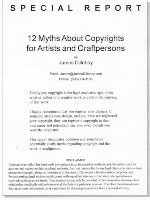
5
Things Every Craft Artist Must Know About
|
Here are five misconceptions regarding copyright about which every craft artist needs to get clear.
#1 “Someone buys my original art and now has the right to reproduce it.”
False. Even if you sell an original, you control the rights to reproduce and sell or distribute copies, not the purchaser. The exception being when they specifically buy the copyright from you, which you should not do without careful consideration and large remuneration.
#2 “If a craft item doesn't show a copyright notice, it is not legally copyrighted.”
False now but was true in the past. Almost everything created privately and originally after April 1, 1989 is copyrighted and protected whether the piece contains a notice or not. You should assume for other artist's works that they are copyrighted and may not be copied unless you have permission or you know otherwise. It is true that a notice strengthens the protection, but it is not necessary. If it looks copyrighted, you should assume it is. This applies to pictures, too. You may not scan pictures from magazines and use them in your work without permission.
#3 “The work is in the public domain, so I don't have to get permission to use it.”
Don’t count on it. Public domain refers to the lack of copyright protection. A design or piece of work may have become trademarked or identified as a logo for its originator. Works not registered or protected under copyright, may enjoy protection by trademark or some other form of contract law. Also, identifiable people such as celebrities may have rights as to the manner in which their name or likeness is used.
#4 “If I don't make money from the sale, I'm not in violation of an artist's copyright.”
False. Whether you ask money or not may affect the damages awarded in a lawsuit, but it's still a violation if you take control of someone else’s design and give it away. You may be found guilty of causing the originator damages by hurting the commercial value of the piece.
#5 “The design / artwork I plan to copy was in an out-of-print book. Therefore, the design is in the public domain and I don’t need permission.”
Don’t count on it. A book can go out-of-print while still being covered by copyright. A book that is out-of-print is considered in a temporary state. The copyrights usually go back to the author or illustrator, which means the underlying copyright protection is still in effect.
Forms for registering copyright for craft designs / visual artists
 About
the Author
About
the Author
James Dillehay, author of seven books, is a nationally recognized expert
on marketing arts and crafts. Artist, entrepreneur, and educator, his
articles have helped over 15,000,000 readers of Family Circle, The Crafts
Report, Better Homes & Gardens, Sunshine Artist, Ceramics Monthly,
and more. James has appeared as a featured guest on HGTV's popular The
Carol Duvall Show and he is a member of the advisory board to The National
Craft Association. This article is copyrighted and excerpted from the
Special Report, 12 Myths of Copyright
for Artists and Craftspeople
Copyright 2012. All rights reserved.